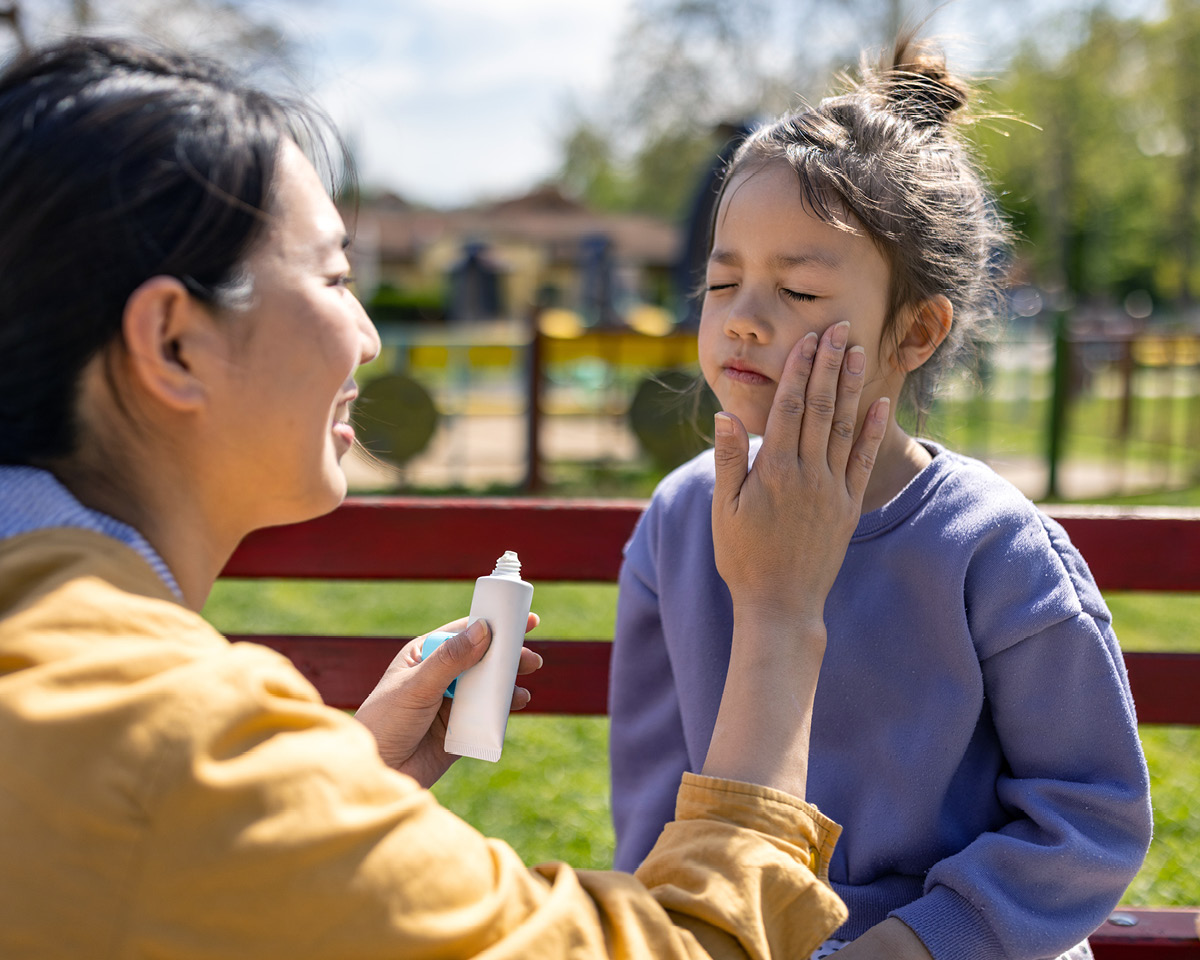Here’s How a Pediatrician Chooses the Best Sunscreen for Kids

Every summer, the same fierce battle breaks out in homes across the country: Parent versus kid versus sunscreen. And then, an hour later, a rematch: Parent versus kid versus sunscreen re-application. It’s an annoying struggle, but it’s a virtuous one, too, because one of the most important ways you can protect your kid’s health is shielding their skin from the sun.
The earlier and more often kids are exposed to ultraviolet radiation — the radiation emitted by the sun in the form of UVA and UVB rays — the higher their risk of developing skin cancer. What’s more, explains Laird Vermont, MD, WashU pediatrician at Monarch Pediatrics, “The skin barrier to ultraviolet radiation is not as effective when you’re a kid, so children are more prone to damage that can cause rashes, hyperpigmentation, photoaging and skin cancer.”
To help protect your child’s skin this summer, Vermont offers this advice on what to look for in a sunscreen and other tips for staying safe in the sun.
What is the difference between mineral and chemical sunscreen?
Mineral sunscreen, sometimes called inorganic or physical sunscreen, uses zinc oxide and titanium dioxide to form a barrier on the skin. Mineral sunscreens:
- Reflect the sun’s UV rays.
- Are sticky and a bit difficult to apply. They also leave a white cast on the skin.
- Are considered the safest formulations because there’s no evidence that they penetrate the skin barrier and are absorbed into the body.
Pro tip: If applying sunscreen to your little one is a battle, try a sunscreen stick, which is typically a mineral formula. Let your child “draw” on themselves before rubbing in the sunscreen. “This is more fun than getting wiped down,” Vermont says.
Chemical sunscreen, or organic sunscreen, is probably the type of sunscreen you’re most familiar with. Chemical sunscreens:
- Absorb the sun’s UV rays and turn them into a tiny amount of heat.
- Are easy to apply.
- Have been shown to penetrate the skin and can be detected in bodily fluids. There’s no conclusive evidence that this causes cancer or other health problems, but “for me, that’s a little concerning,” Vermont says.
Pro tip: Skip the spray sunscreen. “People do it because it’s easier to apply, but those sunscreens have more of the organic chemical ingredients, and you can inhale it, which is not good,” Vermont says. “It’s also variable in application.”
What is micronized mineral, or nano zinc, sunscreen?
If you’re shopping for sunscreen and notice a mineral product that uses microparticles of zinc oxide and titanium dioxide, Vermont says, you should know that these are minerals that have been ground down so they’re smaller, aren’t as difficult to apply and don’t leave as much of a white cast. However, there’s conversation about whether those smaller particles can penetrate the skin barrier and be absorbed by the body. “There aren’t conclusive studies saying that the microparticles are more dangerous, but if you can use the non-micronized sunscreen, it might be a little bit safer pending more studies,” Vermont says.
Can my baby wear sunscreen?
If you have a child who is younger than 6 months, skip the sunscreen, dress them in UV protective clothing and keep them out of direct sunlight.
Vermont advises in cases where you can’t limit a baby’s sun exposure — if you’re on the beach, for example, and you know you’re going to be outside for a long time — consider using a mineral sunscreen on exposed body parts that you can't cover up: your baby’s face, the backs of their hands and their feet.
Which SPF should I choose?
SPF — or sun protection factor — is the measurement of how much UV radiation is needed to produce a sunburn on protected skin versus unprotected skin. SPF 30 or higher is recommended, but, Vermont says, “most people don’t put enough sunscreen on, so you might want to try using a higher SPF. It will give you some extra protection.”
How often should I reapply sunscreen on my kids?
Apply sunscreen 30 minutes before going outside, and wait 10 minutes before dressing so it doesn’t absorb into your clothes or swimwear. You should reapply sunscreen every 40 minutes if swimming or 80 minutes if sweating.
How much sunscreen should I use on my kids?
An adult needs a shot glass’ worth, or about 1 ounce, of sunscreen every time they apply. Use half the amount on a child.
Does sun protective clothing work better than sunscreen?
The perk of good sun protective clothing, or UPF clothing, is that, unlike sunscreen, you can’t wash or sweat it off. Look for clothing that is labeled UPF 50 or higher, has a tight weave and is a dark color. “Light clothing does tend to reflect sunlight, but as far as UV radiation goes, darker colors tend to absorb it, so it doesn’t get to your skin,” Vermont says.
Need help finding a pediatrician? We’re here to assist. Learn more about what factors to consider when choosing a provider.
Recent News
Article
Breathe Easier: Tips for Improving Your Lung Health
News
An Empowering Pregnancy Journey
Article
Chenitra Emergency Care
Article
Leading The Way in Lung Cancer Diagnosis
Article
Safety Tips for 4th of July Firework Fun
Article